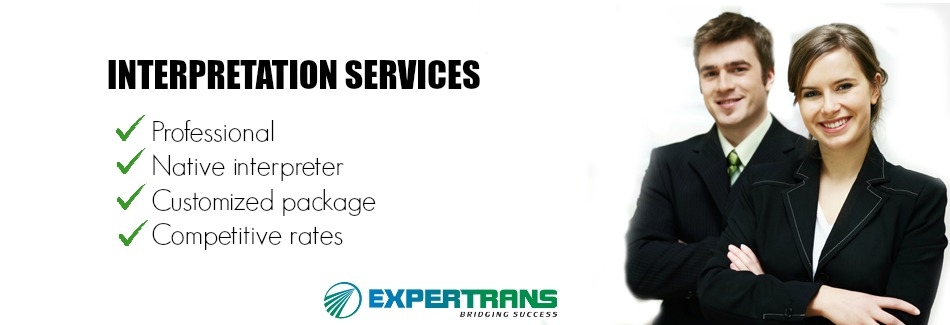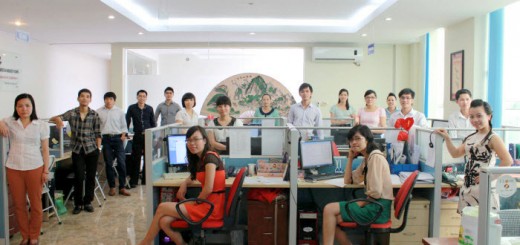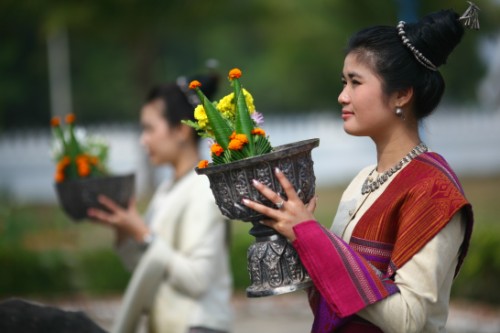Grammar
The basic word order of the Burmese language is subject-object-verb. Pronouns in Burmese vary according to the gender and status of the audience. Burmese is monosyllabic (i.e., every word is a root to which a particle but not another word may be prefixed).[44] Sentence structure determines syntactical relations and verbs are not conjugated. Instead they have particles suffixed to them. For example, the verb "to eat," စား ca: [sà] is itself unchanged when modified.
Adjectives
Burmese does not have adjectives per se. Rather, it has verbs that carry the meaning "to be X", where X is an English adjective. These verbs can modify a noun by means of the grammatical particle တဲ့ tai. [dɛ̰] in colloquial Burmese (literary form: သော sau: [θɔ́], which is suffixed as follows:
Colloquial: ချောတဲ့လူ hkyau: tai. lu [tɕʰɔ́ dɛ̰ lù]
Formal: ချောသောလူ hkyau: so: lu
Gloss: "beautiful" + adjective particle + "person"
Adjectives may also form a compound with the noun (e.g. လူချော lu hkyau: [lù tɕʰɔ́] "person" + "be beautiful").
Comparatives are usually ordered: X + ထက်ပို htak pui [tʰeʔ pò] + adjective, where X is the object being compared to. Superlatives are indicated with the prefix အ a. [ʔə] + adjective + ဆုံး hcum: [zóʊɴ].
Numerals follow the nouns they modify. Moreover, numerals follow several pronunciation rules that involve tone changes (low tone → creaky tone) and voicing shifts depending on the pronunciation of surrounding words. A more thorough explanation is found on Burmese numerals.
Verbs
The roots of Burmese verbs
are almost always suffixed with at least one particle which conveys
such information as tense, intention, politeness, mood, etc. Many of
these particles also have formal/literary and colloquial equivalents. In
fact, the only time in which no particle is attached to a verb is in
imperative commands. However, Burmese verbs are not conjugated in the
same way as most European languages; the root of the Burmese verb always
remains unchanged and does not have to agree with the subject in
person, number or gender.
The most commonly used verb particles and their usage are shown below with an example verb root
စား ca: [sá] "to eat". Alone, the statement
စား is imperative.
The suffix
တယ် tai [dɛ̀] (literary form:
သည် sany [ðì] can be viewed as a particle marking the present tense and/or a factual statement:
- စားတယ် ca: tai [sá dɛ̀] "I eat"
The suffix
ခဲ့ hkai. [ɡɛ̰]
denotes that the action took place in the past. However, this particle
is not always necessary to indicate the past tense such that it can
convey the same information without it. But to emphasize that the action
happened before another event that is also currently being discussed,
the particle becomes imperative. Note that the suffix
တယ် tai [dɛ̀] in this case denotes a factual statement rather than the present tense:
- စားခဲ့တယ် ca: hkai. tai [sá ɡɛ̰ dɛ̀] "I ate"
The particle
နေ ne [nè] is used to denote an action in progression. It is equivalent to the English '-ing'"
- စားနေတယ် ca: ne tai [sá nè dɛ̀] "I am eating"
This particle
ပြီ pri [bjì],
which is used when an action that had been expected to be performed by
the subject is now finally being performed, has no equivalent in
English. So in the above example, if someone had been expecting you to
eat and you have finally started eating, the particle
ပြီ is used as follows:
- (စ)စားပြီ (ca.) ca: pri [(sə) sá bjì] "I am (now) eating"
The particle
မယ် mai [mɛ̀] (literary form:
မည် many [mjì] is used to indicate the future tense or an action which is yet to be performed:
- စားမယ် ca: mai [sá mɛ̀] "I will eat"
The particle
တော့ tau. [dɔ̰] is used when the action is about to be performed immediately when used in conjunction with
မယ်. Therefore it could be termed as the "immediate future tense particle".
- စားတော့မယ် ca: tau. mai [sá dɔ̰ mɛ̀] "I'm going to eat (straight-away)"
When
တော့ is used alone, however, it is imperative:
- စားတော့ ca: tau. [sá dɔ̰] "Eat (now)"
Verbs are negated by the particle
မ ma. [mə], which is prefixed to the verb. Generally speaking, other particles are suffixed to that verb, along with
မ.
The verb suffix particle
နဲ့ nai. [nɛ̰] (literary form:
နှင့် hnang. [n̥ɪ̰ɴ] indicates a command:
- မစားနဲ့ ma.ca: nai. [məsá nɛ̰] Don't eat
The verb suffix particle
ဘူး bhu: [bú] indicates a statement:
- မစားဘူး ma.ca: bhu: [məsá bú] "[I] don't eat"
Nouns
Nouns in Burmese are pluralized by suffixing the particle
တွေ twe [dè] (or
[tè] if the word ends in a glottal stop) in colloquial Burmese or
များ mya: [mjà] in formal Burmese. The particle
တို့ (tou.
[to̰], which indicates a group of persons or things, is also suffixed to the modified noun. An example is below:
- မြစ် mrac [mjɪʔ] "river"
- မြစ်တွေ mrac twe [mjɪʔ tè] "rivers" (colloquial)
- မြစ်များ mrac mya: [mjɪʔ mjá] "rivers" (formal)
- မြစ်တို့ mrac tou: [mjɪʔ to̰] "rivers"
Plural suffixes are not used when the noun is quantified with a number.
"five children"
| ကလေး |
၅ |
ယောက် |
| hka.le: |
nga: |
yauk |
| /kʰəlé |
ŋá |
jaʊʔ/ |
| child |
five |
classifier |
Although Burmese does not have grammatical gender (e.g. masculine or
feminine nouns), a distinction is made between the sexes, especially in
animals and plants, by means of suffix particles. Nouns are masculinized
with the following particles:
ထီး hti: [tʰí],
ဖ hpa [pʰa̰], or
ဖို hpui [pʰò], depending on the noun, and feminized with the particle
မ ma. [ma̰]. Examples of usage are below:
- ကြောင်ထီး kraung hti: [tɕàʊɴ tʰí] "male cat"
- ကြောင်မ kraung ma. [tɕàʊɴ ma̰] "female cat"
- ကြက်ဖ krak hpa. [tɕɛʔ pʰa̰] "rooster/cock"
- ထန်းဖို htan: hpui [tʰáɴ pʰò] "male toddy palm plant"
Numerical classifiers
Main article: Burmese numerical classifiers
Like its neighboring languages such as Thai, Bengali, and Chinese,
Burmese uses numerical classifiers (also called measure words) when
nouns are counted or quantified. This approximately equates to English
expressions such as "two slices of bread" or "a cup of coffee".
Classifiers are required when counting nouns, so
ကလေး ၅ hka.le: nga: [kʰəlé ŋà] (lit. "child five") is ungrammatical, because the measure word for people
ယောက် yauk [jaʊʔ] needs to suffix the numeral.
The standard word order of quantified words is: quantified noun + numeral adjective + classifier, except in round numbers
(numbers that end in zero), in which the word order is flipped, where
the quantified noun precedes the classifier: quantified noun +
classifier + numeral adjective. The only exception to this rule is the
number 10, which follows the standard word order.
Measurements of time, such as "hour,"
နာရီ "day,"
ရက် or "month,"
လ do not require classifiers.
Below are some of the most commonly used classifiers in Burmese.
| Burmese |
MLC |
IPA |
Usage |
Remarks |
| ယောက် |
yauk |
[jaʊʔ] |
for people |
Used in informal context |
| ဦး |
u: |
[ʔú] |
for people |
Used in formal context and also used for monks and nuns |
| ပါး |
pa: |
[bá] |
for people |
Used exclusively for monks and nuns of the Buddhist order |
| ကောင် |
kaung |
[kàʊɴ] |
for animals |
|
| ခု |
hku. |
[kʰṵ] |
general classifier |
Used with almost all nouns except for animate objects |
| လုံး |
lum: |
[lóʊɴ] |
for round objects |
|
| ပြား |
pra: |
[pjá] |
for flat objects |
|
| စု |
cu. |
[sṵ] |
for groups |
Can be [zṵ]. |
Particles
The Burmese language makes prominent usage of particles (called
ပစ္စည်း
in Burmese), which are untranslatable words that are suffixed or
prefixed to words to indicate level of respect, grammatical tense, or
mood. According to the
Myanmar–English Dictionary (1993), there are 449 particles in the Burmese language. For example,
စမ်း [sáɴ] is a grammatical particle used to indicate the imperative mood. While
လုပ်ပါ ("work" + particle indicating politeness) does not indicate the imperative,
လုပ်စမ်းပါ
("work" + particle indicating imperative mood + particle indicating
politeness) does. Particles may be combined in some cases, especially
those modifying verbs.
Some particles modify the word's part of speech. Among the most prominent of these is the particle
အ [ə], which is prefixed to verbs and adjectives to form nouns or adverbs. For instance, the word
ဝင် means "to enter," but combined with
အ, it means "entrance"
အဝင်. Also, in colloquial Burmese, there is a tendency to omit the second
အ in words that follow the pattern
အ + noun/adverb +
အ + noun/adverb, like
အဆောက်အအုံ, which is pronounced
[əsʰaʊʔ ú] and formally pronounced
[əsʰaʊʔ əòʊɴ].
Pronouns
Subject pronouns
begin sentences, though the subject is generally omitted in the
imperative forms and in conversation. Grammatically speaking, subject
marker particles
က [ɡa̰] in colloquial,
သည် [θì]
in formal) must be attached to the subject pronoun, although they are
also generally omitted in conversation. Object pronouns must have an
object marker particle
ကို [ɡò] in colloquial,
အား [á]
in formal) attached immediately after the pronoun. Proper nouns are
often substituted for pronouns. One's status in relation to the audience
determines the pronouns used, with certain pronouns used for different
audiences.
Polite pronouns are used to address elders, teachers and strangers,
through the use of feudal-era third person pronouns in lieu of first and
second person pronouns. In such situations, one refers to oneself in
third person:
ကျွန်တော် kya. nau [tɕənɔ̀] for men and
ကျွန်မ kya. ma. [tɕəma̰] for women, both meaning "your servant", and refer to the addressee as
မင်း min [mɪ́ɴ] "your highness",
ခင်ဗျား khang bya: [kʰəmjá] "master, lord" (from
Burmese သခင်ဘုရား, meaning "lord master") or
ရှင် hrang [ʃɪ̀ɴ] "ruler/master".
So ingrained are these terms in the daily polite speech that people use
them as the first and second person pronouns without giving a second
thought to the root meaning of these pronouns.
When speaking to a person of the same status or of younger age,
ငါ nga [ŋà] "I/me" and
နင် nang [nɪ̀ɴ] "you" may be used, although most speakers choose to use third person pronouns. For example, an older person may use
ဒေါ်လေး dau le: [dɔ̀ lé] "aunt" or
ဦးလေး u: lei: [ʔú lé] "uncle" to refer to himself, while a younger person may use either
သား sa: [θá] "son" or
သမီး sa.mi: [θəmí] "daughter".
The basic pronouns are:
| Person |
Singular |
Plural* |
| Informal |
Formal |
Informal |
Formal |
| First person |
ငါ
nga
[ŋà] |
ကျွန်တော်‡
kywan to
[tɕənɔ̀]
ကျွန်မ†
kywan ma.
[tɕəma̰] |
ငါဒို့
nga tui.
[ŋà do̰] |
ကျွန်တော်တို့‡
kywan to tui.
[tɕənɔ̀ do̰]
ကျွန်မတို့†
kywan ma. tui.
[tɕəma̰ do̰] |
| Second person |
နင်
nang
[nɪ̀ɴ]
မင်း
mang:
[mɪ́ɴ] |
ခင်ဗျား‡
khang bya:
[kʰəmjá]
ရှင်†
hrang
[ʃɪ̀ɴ] |
နင်ဒို့
nang tui.
[nɪ̀ɴ do̰] |
ခင်ဗျားတို့‡
khang bya: tui.
[kʰəmjá]
ရှင်တို့†
hrang tui.
[ʃɪ̀ɴ] |
| Third person |
သူ
su
[θù] |
(အ)သင်
(a.) sang
[(ʔə)θìɴ] |
သူဒို့
su tui.
[θù do̰] |
သင်တို့
sang tui.
[θìɴ] |
- * The basic particle to indicate plurality is တို့ tui., colloquial ဒို့ dui..
- ‡ Used by male speakers.
- † Used by female speakers.
Other pronouns are reserved for speaking with bhikkhus (Buddhist monks). When speaking to a bhikkhu, pronouns like
ဘုန်းဘုန်း bhun: bhun: (from
ဘုန်းကြီး phun: kri: "monk"),
ဆရာတော် chara dau [sʰəjàdɔ̀] "royal teacher", and
အရှင်ဘုရား a.hrang bhu.ra: [ʔəʃɪ̀ɴ pʰəjá] "your lordship" are used depending on their status
ဝါ when referring to oneself, terms like
တပည့်တော် ta. paey. tau "royal disciple" or
ဒကာ da. ka [dəɡà], "donor" are used. When speaking to a monk, the following pronouns are used:
| Person |
Singular |
| Informal |
Formal |
| First person |
တပည့်တော်†
ta.paey. tau |
ဒကာ†
da. ka
[dəɡà] |
| Second person |
ဘုန်းဘုန်း
bhun: bhun:
[pʰóʊɴ pʰóʊɴ]
(ဦး)ပဉ္စင်း
(u:) pasang:
[(ʔú) bəzín] |
အရှင်ဘုရား
a.hrang bhu.ra:
[ʔəʃɪ̀ɴ pʰəjá]
ဆရာတော်‡
chara dau
[sʰəjàdɔ̀] |
- † The particle ma. မ is suffixed for women.
- ‡ Typically reserved for the chief monk of a kyaung (monastery_.
In colloquial Burmese, possessive pronouns are contracted when the
root pronoun itself is low toned. This does not occur in literary
Burmese, which uses ၏
[ḭ] as postpositional marker for possessive case instead of
ရဲ့ [jɛ̰]. Examples include the following:
- ငါ [ŋà] "I" + ရဲ့ (postpositional marker for possessive case) = ငါ့ [ŋa̰] "my"
- နင် [nɪ̀ɴ] "you" + ရဲ့ (postpositional marker for possessive case) = နင့် [nɪ̰ɴ] "your"
- သူ [θù] "he, she" + ရဲ့ (postpositional marker for possessive case) = သူ့ [θṵ] "his, her"
The contraction also occurs in some low toned nouns, making them possessive nouns (e.g.
အမေ့ or
မြန်မာ့, "mother's" and "Myanmar's" respectively).

































